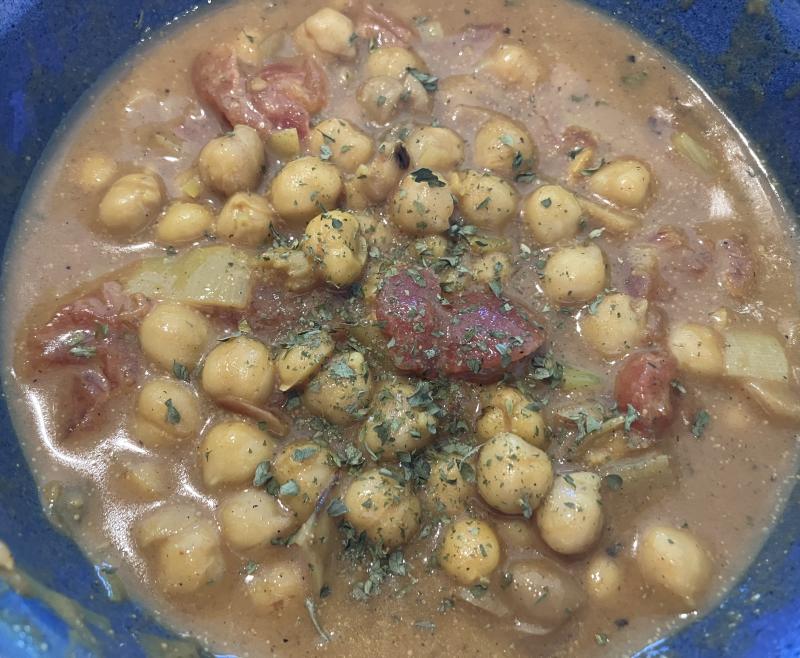Welcome curry to the menu rotation
After years of never wanting to taste curry, last week I had curry dishes three times. I felt a hesitation similar to that of many people I’ve spoken with: afraid I might not like it or afraid it might be too spicy. Instead, I was pleasantly surprised. The garbanzo bean curry in the photo had a creamy texture, filled with warm (not too hot) spices and a lovely balance of flavors.
For those of you who may not be familiar with curry, it originated in the Indian subcontinent. The name itself comes from the Tamil word “kari” which originally referred to a cooking pot, but now refers to a sauce or soup to be eaten with rice. Like so many dishes with a long history, the ingredients in curry vary widely, with many regional signatures.
Archeological evidence along the Asian trade routes have found pottery shards indicating pepper, ginger, garlic, and turmeric were in use as early as 2600 BCE. With extensive sea travel into the modern era, Portuguese, British, and Dutch traders influenced the ingredients found in curry dishes. By the time of the exploration of the Americas, we saw tomatoes enter the mix.
Originally, the spices were ground separately; the seasoning mixture we call “curry powder” is a relatively modern invention. And, if you research the components of curry powder, you will not find a consistent answer. Cumin, turmeric, and pepper are typically included, but additional spices can be coriander, ginger, cinnamon, and cayenne. The other feature of a recipe for a curry dish is the preparation step to “bloom” the spices.
Often, we will be instructed to stir in seasonings. When making curry, you first sauté onions with garlic, then before adding any liquid ingredients, you sprinkle the spices into the pan to heat them and infuse the solids with their flavor. From there, liquid ingredients are added to the rich flavor base - coconut milk and / or tomatoes with their juices.
On the subject of coconut milk, be sure to select the unsweetened milk, not the heavily sweetened cream. What is labeled coconut milk is the liquid found inside the coconut. Imagine you are on a tropical isle and you are handed a coconut that has been pierced with a straw. What you will sip is the coconut milk, well-known for its hydrating properties.
However, once the liquid is canned, it separates and a thick layer forms on the top. When you open the can you will see a dense white waxy-looking material. The best approach is to use a knife or spoon to break through this and scoop out a section to reveal the clear liquid underneath. Now, when you pour it into the pan, you won’t make a messy splash.
I have included two recipes, one is a vegetarian chickpea curry and the other is a basic version of chicken curry. For the first, you are welcome to source all fresh ingredients, but it is so easy to rely on canned chickpeas and tomatoes, which makes the dish come together quickly. For a thicker consistency, you can smash some of the chickpeas into the sauce. I ate this on its own, but it’s also delicious over rice.
The chicken curry recipe is quite basic. You can make it hotter by adding a bit of cayenne pepper and you can stir in chopped tomatoes for additional color. If you serve it over rice, be sure to choose Basmati, as the fragrant grain goes well with the curry flavors. Welcome curry to the menu rotation!
Allie’s Chickpea Curry
1 chopped onion
3 minced garlic cloves
2 15-oz cans chickpeas
2 T curry powder
1 t cumin
1 t cinnamon
15-oz can diced tomatoes
15-pz can coconut milk
juice of 1 lime
1/4 C chopped cilantro
Sauté the onion and garlic in a splash of water over low until softened. Drain and rinse the chickpeas; add to the pan. Stir in curry powder, cumin, and cinnamon. Cook over medium until fragrant, about 3 minutes. Add tomatoes with their juices and cook for a few minutes. Stir in coconut milk and reduce to low. Simmer until thickened, about 10 minutes. Add lime juice and serve garnished with cilantro. Yield: 4 servings.
Simple Chicken Curry
1 T olive oil
2 minced garlic cloves
2 t grated ginger
1 chopped onion
2 1/2 T curry powder
1 lb boneless chicken thighs
1 1/4 C coconut milk
2/3 C chicken stock
3/4 C frozen peas
salt, to taste
1/4 C chopped cilantro
Heat oil in a skillet over medium high heat. Add garlic, ginger, and onion; cook for 3 minutes. Add curry powder and cook for 2 minutes. Cut chicken into 1/2-inch thick slices. Add to pan and cook until color changes from pink to white. Add coconut milk and chicken stock. Stir, lower heat to medium and simmer until sauce reduces and thickens. about 10 minutes. Add peas and season to taste with salt. Cook another 2 minutes. Serve over basmati rice. Garnish with cilantro. Yield: 4 servings.





















































